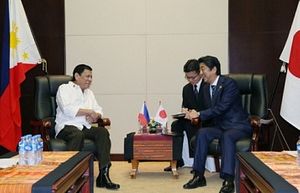Two Japanese aircraft will be officially transferred to the Philippine Navy next week in a boost for Manila’s limited capabilities and an indicator of the significance of the bilateral defense relationship.
According to the Japan Ministry of Defense’s Acquisition, Technology, and Logistics Agency (ATLA), two Japan Maritime Self Defense Force (JMSDF) TC-90 training aircraft will be officially transferred to the Philippine Navy on March 27. In a confirmation on Monday, the agency said that the aircraft would leave on Tokushima Air Base on March 23, with an arrival ceremony to be held at Naval Base Heracleo Alano in Sangley Point, Cavite City.
The aircraft are part of a deal reached during the previous administration of Benigno Aquino III where Japan would lease the Philippines five Beechcraft TC-90 King Air Planes. When the deal gained steam last year, it grabbed headlines because it would mark the first time for Japan to lend military aircraft to a foreign country following its lifting of a self-imposed ban on weapons exports (See: “Philippines To Get Five Aircraft From Japan Amid South China Sea Tensions”).
It had also come shortly after both sides had inked a landmark defense equipment and technology agreement, which was just the fourth Tokyo had signed with any country. As I have pointed out before, though attention tends to be overly focused on the Philippines’ relationship with its treaty ally, the United States, Japan is another of the key security partners that Manila has been cultivating. Thus far, signs are that this is set to continue under Philippine President Rodrigo Duterte, despite discontinuities in other dimensions of foreign policy (See: “Japan-Philippines Defense Relations Under Duterte: Full Steam Ahead?”).
The ongoing TC-90 transfer is a case in point. The training component of the deal has already gotten underway, with pilots and air crew members leaving for Japan last November to begin their flight training. The Philippines is set to receive all five of the planes by the end of the year, for which it is paying a total of $28,200 under the lease agreement.
Philippine officials have publicly admitted that the TC-90s would be a much-needed capability boost for the military, which remains one of Asia’s weakest. The planes have around twice the range of the existing Norman-Britten BN-2 Islander fleet, which the navy uses for patrol, surveillance, and humanitarian assistance and disaster relief and rapid assessment missions. They are also much faster. The aircraft can also be fitted with additional equipment such as basic surface and air surveillance radar that would make it useful on the South China Sea front.

































